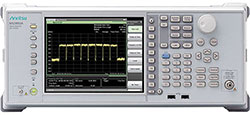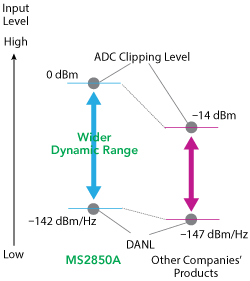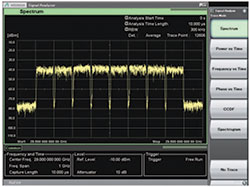
Engineers developing 5G chipsets, modules, components and systems must address design challenges ranging from high frequencies and wide bandwidths, to time and cost constraints. Recognizing the need for performance and efficiency, Anritsu Co. has introduced the Signal Analyzer MS2850A, which provides an attractive price/performance balance and meets the testing requirements of next-generation broadband communications systems such as 5G. The Signal Analyzer MS2850A, with frequency coverage from 9 kHz to 44.5 GHz, has the analysis bandwidth, flatness and wide dynamic range for 5G designs at a price point half that of other analyzers on the market. It features 1 GHz analysis bandwidth to support wideband microwave and mmWave communications, so engineers can analyze frequency and phase, as well as power changes over elapsed time.
WIDEBAND SIGNAL ANALYSIS

Figure 1 The ADC clipping level of 0 dBm enables the MS2850A to have a measurement dynamic range greater than 140 dB at 1 GHz.
Both excellent flatness and dynamic range are required for evaluating the wideband wireless signals used in 5G. At 28 GHz, the in-band frequency response of the MS2850A is typically ±1.2 dB, and phase linearity is 5 degrees peak-to-peak. This best-in-class performance over the 1 GHz analysis bandwidth provides high accuracy amplitude and phase measurements for each carrier. Advantageous in a variety of 5G design and production environments, this level of performance provides particular benefits when verifying 5G antenna arrays.
The Signal Analyzer MS2850A has an analog-to-digital converter (ADC) clipping level of 0 dBm over the 1 GHz analysis bandwidth. This enables the instrument to obtain a wider difference from the displayed average noise level (DANL) and suppresses spurious generation. The result is a measurement dynamic range greater than 140 dB at 1 GHz, 8 dB better than similar signal analyzers (see Figure 1). The dynamic range is equivalent to less than a 1 percent error vector magnitude (EVM), which is considered the peak-to-peak of a modulation waveform measuring a single 5G carrier. A built-in attenuator can be set with a resolution of 2 dB, and the level of the input signal to the mixer can be adjusted with high resolution to further leverage the dynamic range.
DEDICATED 5G MEASUREMENT SOFTWARE
Anritsu has written measurement software designed specifically for 5G verification and operational testing, providing advantages compared to off-the-shelf orthogonal frequency-division multiplexing (OFDM) alternatives. It allows the MS2850A, when equipped with 510 MHz or 1 GHz analysis functionality, to support batch measurements of up to eight 100 MHz bandwidth carriers (see Figure 2). Other analyzers can only measure one carrier at a time, which adds time and cost to verification testing during design and production. The software can be installed directly on the MS2850A, eliminating the need for a separate PC, required by most other signal analyzers.

Figure 2 The MS2850A can measure up to eight 100 MHz bandwidth carriers, here centered at 29 GHz.
With the software installed, the MS2850A is the first signal analyzer in its price range to support the pre-5G version of cyclic prefix OFDM (CP-OFDM). Frequency error, transmit power, EVM, timing error and other key parameters of every physical layer (PHY) channel for each carrier can be measured with the signal analyzer. Single carrier measurements can be conducted when necessary.
LARGE MEMORY
To achieve highly accurate results, signal analyzers for 5G designs require large memories to store long-term digitizing data. The MS2850A has a memory that is about 4x more than that available in similar instruments. With the larger memory, the MS2850A can capture 1 GHz signals in only three seconds, creating a more efficient testing environment.
To shorten test times, the MS2850A has a high-speed capability to transfer large capacity digitized data to an external PC. During development, the MS2850A can serve as a digitizer, and test data can be analyzed using custom software developed in-house. In production environments, the digitized data from multiple signal analyzers can be transferred to a server or workstation for intensive analysis and data management.
A signal analyzer function integrates a built-in 255 MHz analysis bandwidth fast Fourier transform (FFT) that supports spectrum, spectrogram and frequency/phase/power vs. time displays, making the MS2850A well-suited for applications where frequency and phase change with elapsed time. With the FFT analysis function, measured signals can be captured and displayed in various domains to improve troubleshooting efficiency, because phenomena such as spectrum transients that cannot be monitored by sweep-type spectrum analyzers can be observed by the MS2850A.
Built on a flexible platform, the MS2850A can be configured to satisfy current test requirements, with an easy upgrade path as requirements expand. This protects the investment in the signal analyzer, providing a greater return on investment.
Anritsu Co.
Morgan Hill, Calif.
www.anritsu.com
